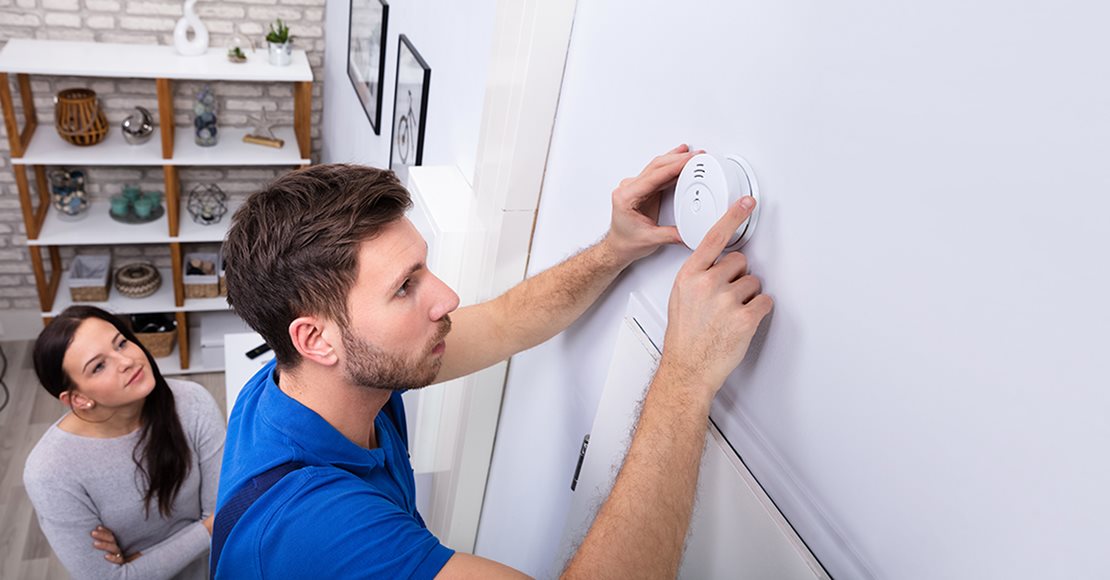
Whether you are a renter, first-time homebuyer, or long-time homeowner, it’s always a good time to have a refresher on fire safety to protect your residence as well as your loved ones. Iowans don’t always have the best safety record when it comes to fires. In fact, according to the US Fire Administration, Iowa had significantly higher death rates for fires (60% more than the national average!), and double the number of fire injuries per 1,000 fires in 2019. Adding to this, 2021, saw a significant increase in the number of fires in Iowa, as well. But it’s not all doom and gloom—you can effectively protect your home and family from the dangers of fire by following these simple tips.
Install Smoke Detectors and Check Them Regularly
According to the National Fire Protection Association, having working smoke detectors in your home cuts your risk of dying in a fire by more than half (55%). Iowa law requires that all housing, whether owned or rented, single-family home, hotel, or apartment, be equipped with both smoke and carbon monoxide detectors. However, it is often up to the residents to install and maintain their own smoke detectors—and unfortunately, human error or neglect can be deadly. In fact, in two-thirds of deaths by fire, smoke detectors were missing or not in operation. Here’s how you can properly protect your home with smoke detectors.
Install smoke detectors in the right places
Smoke detectors on every floor of the home, as well as one in each bedroom, spaces outside bedrooms, living rooms, and stairways. It’s not necessary to install smoke detectors within ten feet of cooking appliances, as this can cause false alarms (which could encourage residents to disable the alarms, creating a potential risk). For more specific information and diagrams for installation, visit the US Fire Administration guide, Installing and Maintaining Smoke Alarms.
Keep extra batteries or smoke detectors on hand
When you start hearing those warning chirps, you’ll know that it’s time to replace your smoke detector batteries—but if you don’t have the right batteries on hand, you could wind up disabling them instead just to stop the noise. Find out what batteries your alarms take, and be sure to have a few on hand so you can replace them right away. First Alert recommends changing batteries every six months. If that feels like too big of a task, or if your smoke alarms are in hard-to-reach places, consider getting ten-year smoke alarms, where you replace the entire unit every ten years, or when it begins to emit its end-of-life warning chirps—whichever comes first. It’s never a bad idea to have a few extra smoke detectors on hand if and when you need to replace, as well. Check out Consumer Reports’ Best Smoke and Carbon Monoxide Detectors of 2022 to help you pick out the best models for your home.
Test them often
Smoke alarms will usually alert you when the battery is running low or if they are nearing the end of their lifespan. But if it is faulty or dead, you may never know it’s not functioning until it’s too late. The US Fire Administration recommends testing your smoke detectors each month by hitting the “test” button. If nothing happens, the smoke detector or battery needs to be replaced. Because 16% of fire deaths occur in homes with non functioning smoke detectors, it’s important to check yours regularly to see if they are in working order.
Go “Smart”
Smoke detectors are effective at preventing deaths when residents are in the home, but if no one is there to hear them, they can’t prevent property damage or save the lives of trapped pets on their own. Smart detectors will sound an alarm in the home, but also notify you of the potential fire via your smartphone so you can get there or notify a neighbor or emergency response to check on your home.
Tom’s Guide provides a number of recommendations for smart smoke detectors. If you have working “non smart” smoke detectors, there are also options for “smart batteries” to put in your existing smoke detectors, as well as services to use your smart speaker to notify you if it hears your existing smoke alarms going off.
Keep fire extinguishers in accessible places and know how to use them
Fire extinguishers can effectively stop a fire before it spreads, but the statistics on home availability of extinguishers are grim: 35% of homes with children don’t have accessible fire extinguishers, and fewer than half of Americans feel confident in using an extinguisher to put out a fire. Here are a few basic things you need to know about extinguishers to keep your family safe.
Have a versatile extinguisher
Common household fire extinguishers are assigned a letter which corresponds to the kinds of fires that they can suppress. ‘A’ extinguishers are for cloth, wood, or paper fires, ‘B’ extinguishers for flammable liquids—grease, oil, gasoline, and certain paints, and ‘C’ extinguishers are for electrical fires. The US Fire Administration breaks down the different types of extinguishers in greater detail here. Be sure that your home extinguishers cover all three classes—A through C—to ensure that you can effectively put out home fires, no matter the cause.
Check dates on fire extinguishers
Disposable or non-rechargeable fire extinguishers last ten to twelve years. They can only be used once, and then must be tossed and replaced. Check your current extinguishers, to be sure that yours will still be effective when needed. If you are setting up your home with ten-year smoke alarms, consider buying some extinguishers at the same time to keep them on the same replacement timeline.
Rechargeable fire extinguishers are more common in commercial settings, but can be used multiple times. However, after each use, or every six years, they must be “recharged” by a certified fire equipment dealer.
An important note: Never test a fire extinguisher to see if it works. It will lose pressure and could be ineffective in an actual fire.
Keep them in reach
The National Fire Protection Association has very specific guidelines for the best placement of extinguishers, but simply put, like smoke detectors, it’s important to have enough in your home, and in the right places. Keep an extinguisher in an easy to access place in your kitchen and near your fireplace, on each floor, and in any other high-risk places your home might have. Be sure that the type of extinguisher matches the kinds of fires most likely to happen in that location (for instance, a ‘B’ extinguisher in the kitchen or garage where oil fires are common).
Know how and when to use them
Most people have never had to use a fire extinguisher, and may not feel confident in their ability to put out a fire with one. To remember the proper way to operate an extinguisher, use the acronym PASS:
- Pull the pin on the extinguisher.
- Aim the hose nozzle low toward the base of the fire.
- Squeeze the handle to release the extinguishing agent.
- Sweep the nozzle from side to side at the base of the flames until extinguished.
There are times when it is better to simply evacuate to safety then try to fight the fire on your own, however. Safety and Health Magazine offers this specific advice for when not to use an extinguisher. In general, if a fire is too large or inaccessible, the space is too hot or the air isn’t safe to breathe, or if the fire is beginning to block your routes to safety, it’s best to evacuate and not attempt to extinguish it. As with any emergency, use your best judgment and emphasize personal safety over protecting your property.
Practice electrical safety
According to Electrical Safety Foundation International, “home electrical fires account for an estimated 51,000 fires each year, nearly 500 deaths, more than 1,400 injuries, and $1.3 billion in property damage.” To prevent electrical fires, practice both safety with your electric device usage, and be sure that the wiring in your home is up to code.
Wiring: Newer homes (less than twenty years old) are probably safe as long as all recent electric work was done by a certified electrician. For older homes, review this checklist by Neighborly of ways to spot bad wiring. Watch out for things like frequently tripped breakers, warm spots in walls, and buzzing sounds coming from wires, switches, and lights. If you suspect any problems, reach out to an electrician right away.
Outlets and Power Strips: Make sure outlets are not warm to the touch—this is a sign there is a safety issue and that it needs to be inspected by a certified electrician. Outlets and powerstrips are only designed to provide so much electricity, and too many devices or high-powered appliances on one can lead to overheating. As John Williamson of Family Handyman explains, “Do not ever plug a space heater or other very high-powered device into a power strip. It can melt the cord, overheat the outlet and start an electrical fire. Instead, plug these appliances directly into the wall outlet and then monitor the temperature of the outlet.”
Cords: Likewise, to avoid overheating, never run cords underneath rugs. Also make sure they are not pressed between furniture and walls, as kinked cords can be serious fire hazards. If a cord becomes frayed, don’t ignore or attempt to repair it. Throw it away or take it to be fixed by a professional.
Space Heaters: In addition to plugging them directly into the wall, make sure that space heaters (as well as other appliances that create heat) are located away from flammable materials—especially beds and bedding and curtains. The New York Times details how to practice safe space heater usage, which includes tips on where to plug it in and where to place it. The most important thing to do: follow the “three-foot rule.” As the Consumer Product Safety Commission puts it: “keep stuff that can light on fire at least 3 feet away from portable space heaters.” And never leave them running when you aren’t in the room.
Lights: Incandescent light bulbs, which put out heat to make the light, are known fire hazards. If you have these bulbs in your home, be sure that light bulbs are not within twelve inches of combustible materials. This is especially true in closets and attics. To avoid the risks of incandescent bulbs (while increasing your home’s energy efficiency!) consider switching to low-temperature LED lighting.
Maintain your fireplaces and use with caution
There’s nothing like a crackling fire, especially on a cold winter night. But fireplaces also can be dangerous: causing over 4,000 fires each year. Fortunately, making them safer is as easy as routine maintenance and a few preventative practices.
If you have an indoor fireplace or stove, be sure to clean your chimney every year to avoid creosote build up. As the Chimney Safety Institute of America explains, “Because creosote is formed from unburned wood particles, all forms of creosote are highly combustible. If the temperature within the flue is right, the creosote inside could ignite and cause a chimney fire.” Your chimney should also have some kind of fire stopping at each floor, like gypsum board, to prevent fire from traveling up your chimney and spreading through your house. To make sure that the fire stays in your fireplace, always use a firescreen to prevent sparks or shifting logs from entering your living space. And never store fuel or other flammable items in close proximity to your fireplace.
If you have an outdoor fireplace or pit, be sure to follow your local ordinances to ensure fire safety. Best practices include not lighting fires under trees or awnings, or within twenty feet of other structures, unless in a designated fireplace with adequate safety precautions.
Make an escape plan and review it with your family
Once you've taken precautions to prevent fires, you should also have a plan to escape your home in case disaster does strike. Make plans for two escape routes from each room in your home and a designated meeting place outside. If you have children, be sure to explain these escape plans in simple ways, particularly for their own bedrooms and review the plan periodically to keep it fresh in everyone’s minds, as well. Follow these escape plan tips from the US Fire Administration to make the most effective plan for your family.
Protect your assets
While the safety of yourself and your family should be your top priority in a fire, there are ways to protect your assets, as well as your important documents and treasured items, in the case of a fire.
Use a Fireproof Safe or Safe Deposit Box
Although fireproof safes can’t prevent fires, they can protect your important documents from a fire in your home, as well as theft. The Spruce offers this recent list of the best fireproof safes, the best withstanding temperatures up to 1700 degrees Fahrenheit. While at-home safes are good for documents and other replaceable items you need to access regularly, a safe deposit box at your local bank can be more affordable and more resistant to theft. This article by the FDIC explains the best uses of both, and when the added security of a safe deposit box is the right choice.
Get quality insurance
Insuring your home, rental, or other property is a major step in protecting your assets against loss by fire. It’s important to work with a trusted insurance agent to make sure that your policy not only covers fire, but will adequately cover your losses. Lincoln Savings Bank offers many insurance plans to fit your budget for homes, rentals, and vehicles.
How Lincoln Savings Bank Can Help You
Protect your home or assets from disasters like fire. Owned and managed by Iowans, we’ve been serving communities here for over one hundred years. Contact us, stop by a local branch, or reach out to one of our dedicated insurance agents today to learn more about how we can help you, too!
Insurance Products are: Not FDIC Insured | No Bank Guarantee | May Lose Value | Not a Deposit | Not Insured by any Federal Government Agency



